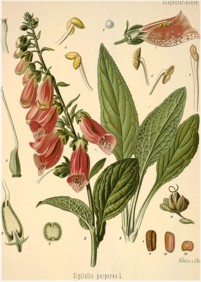Fearsome Foxglove
By Audrey Stallsmith

Let me thy vigils keep
'Mongst boughs pavilion'd, where the deer's swift leap
Startles the wild bee from the foxglove bell.
"O, Solitude!" By John Keats
Years ago I read a Christie story where someone accidentally gathered foxglove leaves along with the salad greens--to make a very nasty side-dish indeed! I didn't know what foxglove was at the time, but it sounded sinister enough.
As in most mysteries, however, the "accident" turned out to be something else, though the culprit was not actually those leaves. Someone had taken the precaution of supplementing the unpredictable amount of poison in Digitalis purpurea plants with the much more concentrated heart medicine made from the same.
Foxglove grows wild in England and, since a single plant can produce over a million seeds, it does sow itself prolifically in unexpected places. And, being a biennial, it only produces a low cluster of leaves during its first year. Still, I doubt that anybody would mistake it for lettuce, though it might be confused with comfrey.
Like many other cold-hearted beauties, this statuesque "fox" can be deadly. Perhaps it is that combination of beauty and danger that makes foxglove stand for "insincerity" in the Language of Flowers.
But, to give the lady her due, she has probably saved far more lives than she ever took. As mentioned above, foxglove is the source of the medicine known as digitalis that both strengthens and slows the pulse. And it makes an effective antidote for aconite (monkshood) poisoning.
It derives its Latin name from digitabulum ("thimble"). Because the blossoms slip so neatly over the tips of human fingers, the plant was sometimes known as dead man's thimbles, fairy's thimbles, or lady's thimbles, not to mention bloody fingers, finger flower, fairy's glove, Our Lady's (or virgin's) glove, or witch's glove.
The common name may be a corruption of folk's glove, since the "wee folk" were supposed to be particularly fond of this plant. Or "foxglove" might derive from the tradition that those mischievous sprites gave some sly predators conveniently-shaped flowers to muffle their stealthy tread.
Fairies aren't the only little beings who love this plant. As William Wordsworth wrote in "The Sonnet," "bees that soar for bloom,/ High as the highest peak of Furness fells,/ Will murmur by the hour in foxglove bells." Other insects sometimes shelter from rain under the "roofs" of the flowers too.
The spots on those blooms are supposed to be the fingerprints of elves. In Charlotte Bronte's Jane Eyre, the heroine writes whimsically that having sought elves "in vain among foxglove leaves and bells, under mushrooms and beneath the ground-ivy mantling wall nooks, I had at length made up my mind to the sad truth, that they were all gone out of England to some savage country where the woods were wilder and thicker, and the population more scant."
Foxglove is also a powerful diuretic, and was originally employed among the common people as a cure for dropsy (edema). It was even known as Lus Mor ("great herb") to Irish peasants.
A character in George Eliot's Silas Marner "saw the cobbler's wife seated by the fire, suffering from the terrible symptoms of heart disease and dropsy which he had witnessed as the precursors of his mother's death. He felt a rush of pity at the mingled sight and remembrance, and, recalling the relief his mother had found from a simple preparation of foxglove, he promised Sally Oates to bring her something that would ease her, since the doctor did her no good."
In the late 1700's British botanist and doctor William Withering learned about this herbal treatment from "an old woman from Shropshire." He discovered that it did, indeed, relieve the symptoms of heart disease. And so digitalis became one of the most important plant-derived drugs in history.
Foxglove makes a gorgeous garden plant also, and doesn't mind shade. But the types that I've tried appeared to dislike the richer, wetter sections of the garden. They seem to prefer to grow, as Gerard commented, "in barren sandy ground."
This tendency for foxglove to "go its own way" should be a warning to us. If treated with respect by people who know what they're doing, so-called toxic plants can be a Godsend. But careless use frequently leads to disaster. As an old saying about foxglove warns direly, "It can raise the dead, but it can kill the living."
Image is from Köhler's Medizinal-Pflanzen, courtesy of the Missouri Botanical Garden Library.








